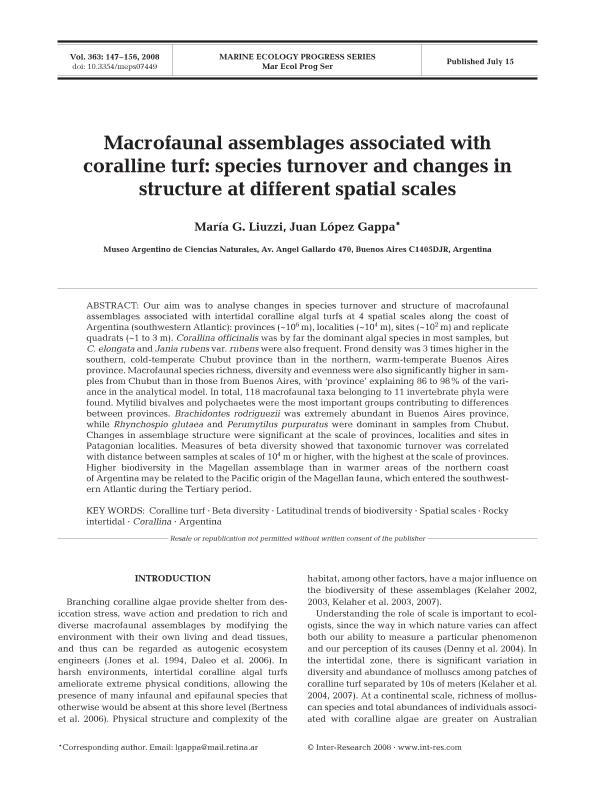Mostrar el registro sencillo del ítem
dc.contributor.author
Liuzzi, Maria Gabriela

dc.contributor.author
López Gappa, Juan José

dc.date.available
2021-07-08T12:29:11Z
dc.date.issued
2008-07
dc.identifier.citation
Liuzzi, Maria Gabriela; López Gappa, Juan José; Macrofaunal assemblages associated with coralline turf: Species turnover and changes in structure at different spatial scales; Inter-Research; Marine Ecology Progress Series; 363; 7-2008; 147-156
dc.identifier.issn
0171-8630
dc.identifier.uri
http://hdl.handle.net/11336/135703
dc.description.abstract
Our aim was to analyse changes in species turnover and structure of macrofaunal assemblages associated with intertidal coralline algal turfs at 4 spatial scales along the coast of Argentina (southwestern Atlantic): provinces (∼106 m), localities (∼104 m), sites (∼10 2 m) and replicate quadrats (∼1 to 3 m). Corallina officinalis was by far the dominant algal species in most samples, but C. elongata and Jania rubens var. rubens were also frequent. Frond density was 3 times higher in the southern, cold-temperate Chubut province than in the northern, warm-temperate Buenos Aires province. Macrofaunal species richness, diversity and evenness were also significantly higher in samples from Chubut than in those from Buenos Aires, with 'province' explaining 86 to 98% of the variance in the analytical model. In total, 118 macrofaunal taxa belonging to 11 invertebrate phyla were found. Mytilid bivalves and polychaetes were the most important groups contributing to differences between provinces. Brachidontes roddguezii was extremely abundant in Buenos Aires province, while Rhynchospio glutaea and Perumytilus purpuratus were dominant in samples from Chubut. Changes in assemblage structure were significant at the scale of provinces, localities and sites in Patagonian localities. Measures of beta diversity showed that taxonomic turnover was correlated with distance between samples at scales of 10 4 m or higher, with the highest at the scale of provinces. Higher biodiversity in the Magellan assemblage than in warmer areas of the northern coast of Argentina may be related to the Pacific origin of the Magellan fauna, which entered the southwestern Atlantic during the Tertiary period.
dc.format
application/pdf
dc.language.iso
eng
dc.publisher
Inter-Research

dc.rights
info:eu-repo/semantics/openAccess
dc.rights.uri
https://creativecommons.org/licenses/by-nc-sa/2.5/ar/
dc.subject
ARGENTINA
dc.subject
BETA DIVERSITY
dc.subject
CORALLINA
dc.subject
CORALLINE TURF
dc.subject
LATITUDINAL TRENDS OF BIODIVERSITY
dc.subject
ROCKY INTERTIDAL
dc.subject
SPATIAL SCALES
dc.subject.classification
Ecología

dc.subject.classification
Ciencias Biológicas

dc.subject.classification
CIENCIAS NATURALES Y EXACTAS

dc.title
Macrofaunal assemblages associated with coralline turf: Species turnover and changes in structure at different spatial scales
dc.type
info:eu-repo/semantics/article
dc.type
info:ar-repo/semantics/artículo
dc.type
info:eu-repo/semantics/publishedVersion
dc.date.updated
2021-07-05T13:47:41Z
dc.journal.volume
363
dc.journal.pagination
147-156
dc.journal.pais
Alemania

dc.description.fil
Fil: Liuzzi, Maria Gabriela. Consejo Nacional de Investigaciones Científicas y Técnicas. Oficina de Coordinación Administrativa Parque Centenario. Museo Argentino de Ciencias Naturales "Bernardino Rivadavia"; Argentina
dc.description.fil
Fil: López Gappa, Juan José. Consejo Nacional de Investigaciones Científicas y Técnicas. Oficina de Coordinación Administrativa Parque Centenario. Museo Argentino de Ciencias Naturales "Bernardino Rivadavia"; Argentina
dc.journal.title
Marine Ecology Progress Series

dc.relation.alternativeid
info:eu-repo/semantics/altIdentifier/doi/https://doi.org/10.3354/meps07449
dc.relation.alternativeid
info:eu-repo/semantics/altIdentifier/url/https://www.int-res.com/abstracts/meps/v363/p147-156/
Archivos asociados
